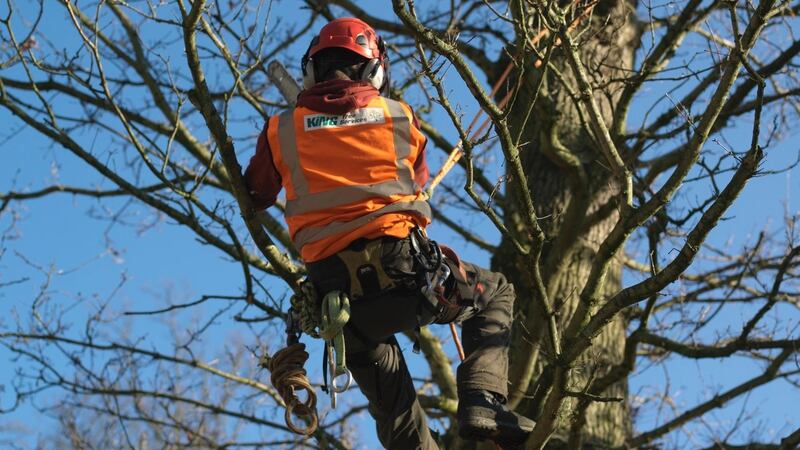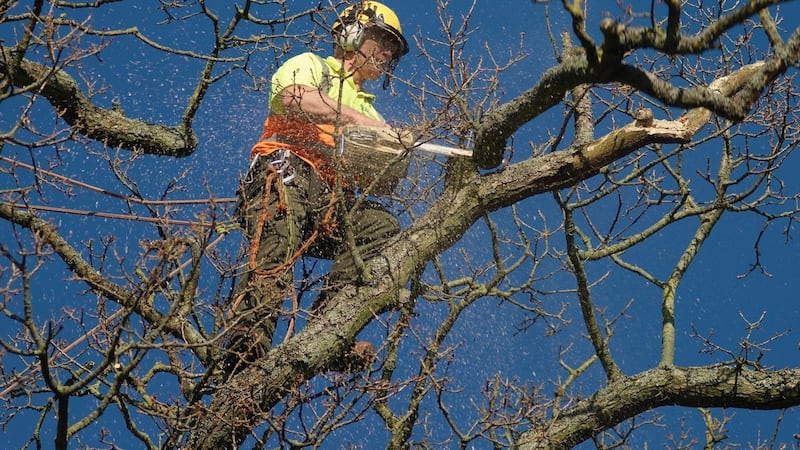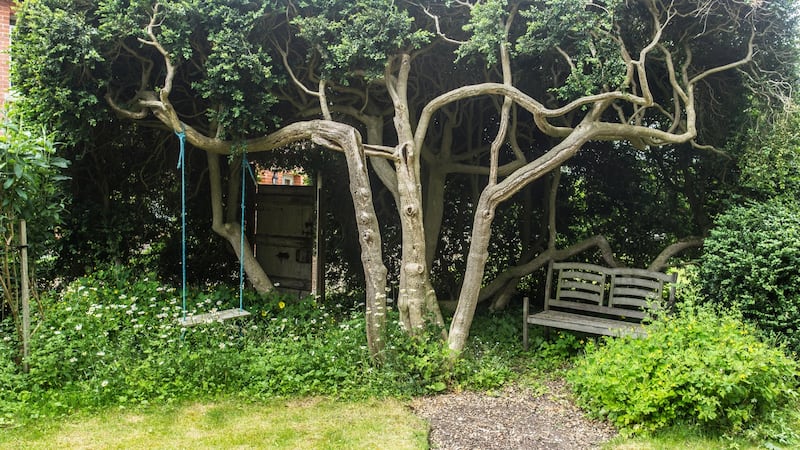Help! We’ve very excited to have recently bought an old house with its own existing garden. We’re about to begin renovation works on the building and would dearly love to preserve/protect as much of the garden’s lovely mature planting as we can during the process but haven’t a clue how to go about it.
Taking on an established garden is both a thrilling and slightly daunting process, especially- as is so often the case- when you’ve also got builders on-site. The uncomfortable truth is that building renovation works are never kind to gardens, particularly mature ones where the vulnerable root systems, trunks and branch/leaf canopies of established trees and large shrubs are so easily damaged by the inappropriate storage of building materials, heavy skips, excavation works or passing machinery.
Even the repeated footfall of workmen is enough to cause serious problems with soil compaction. Add in spillages from cement mixers, paint splatters, discarded piles of builders’ sand and gravel and. . . you get the picture.
So my first words of advice are to be realistic. Almost inevitably there will be some damage to the planting. My next are to start by getting someone – ideally an experienced professional garden designer/qualified horticulturist with expert plant knowledge to properly assess the existing planting and help you to identify those trees, shrubs, climbers etc that are integral to your garden’s special air of leafy maturity.

One highly experienced Irish garden designer and horticulturist with long experience in this field is Bots-trained Dominick Murphy of Dublin-based firm Murphy + Sheanon. He bewails the fact that clients often bring him on board a project at a point when builders and inexpert tree surgeons have already caused irreparable damage to the garden's mature plants as well as to its soil structure.
“It’s so important to start by taking a long, hard look at the site at the very beginning of any renovation or building project, sensitively assessing the existing planting and then ideally sitting down with the client and the architect to make a coherent, long-term plan as to how best to protect it during building works so that it can be successfully integrated into the finished garden.”
It’s worth adding that when you buy a house with a mature garden, you also inherit all of the planting mistakes made by its previous owners. These might include the use of inappropriately large species of trees, overly fast-growing hedging or bamboos with invasive root systems, poorly-situated trees planted dangerously close to buildings or even- God forbid- the accidental introduction of Japanese knotweed, which up until the 1970s was still being sold as an ornamental plant in some Irish garden centres.
Exclusion zones
All of these are good reasons to employ a knowledgeable horticulturist to assess the planting before building work begins so that informed decisions can be made regarding the proper removal of badly damaged, diseased, invasive or unwanted plants as well as whether any tree surgery is required.

The next step of the process is to agree and sign off on what areas of the garden should be fenced off during building works to protect them from damage. “And I do mean fenced off, using proper post-and-rail fencing or metal hoarding,” warns Murphy.
“Forget using tape or rope as these are inevitably ignored.”
These exclusion zones should automatically include any areas of mature planting or individual specimen trees that you wish to preserve. As a rough guide, shrubby areas should be fenced off at least to the extent of the leaf canopy. With a mature tree, best practice is to measure the girth of the trunk at a height of 1.8m above ground level and then multiply this by 12 to give you the final diameter of the exclusion zone required around the tree.

Nothing – no building materials, skips, or machinery- should be stored within these exclusion zones in order to prevent soil compaction causing the slow death of these vulnerable plants.
Keeping manners on a site
Murphy makes the point that even the best builders will always push for more on-site work/storage space than they actually need and very rarely appreciate the dangers of soil compaction. “Weirdly, most builders are more likely to be anxious about damaging an existing lawn than the risks to a mature tree. Yet a lawn can be easily repaired while a decades-old specimen tree is irreplaceable.” So take a very firm line as regards these agreed exclusion zones being properly policed/respected by all contractors throughout the build.
As regards agreeing on an allocated workspace for storing materials, skips and machinery and mixing cement on site, this should be as far away from any planting as possible, with the existing top-soil in this area excavated to a depth of 30-60cm and stacked safely out of the way so that it can be later re-used. Replacing it with a temporary infill of what is known as 804 – a grade of coarse, crushed stone – provides builders with a clean, firm, free-draining working surface and avoids soil compaction.
“It’s all too easy for a property owner to get so caught up with the building/renovation works that they temporarily forget about the garden, even though it’s often the very thing that first made them fall in love with the property.” says Murphy. “But by mapping the journey in advance, you can properly protect established plants. It’s what I call keeping manners on a site.”
See murphysheanon.ie. Another useful website resource is that of the Garden & Landscape Designers Association, glda.ie
This week in the garden
Diseased or storm-damaged trees and large shrubs are much more vulnerable to falling in violent gales so it’s wise to inspect established garden specimens regularly at this time of year.

Avoid attempting tree surgery yourself, especially in the case of dangerously storm-damaged trees, which are called 'widow-makers' for a good reason. Instead ask a properly-qualified and insured contractor for a quote to carry out the work. To find one, contact the Irish branch of the Arboricultural Association (goodwin-arborist.com).
Many polytunnels and glasshouses around the country were also damaged by Storm Ophelia, leaving them far more vulnerable to further damage by any future winter gales, so it’s important to repair them as soon as you can.
Always make sure that all doors/vents/windows are firmly closed and secured during strong winds to protect them from future damage.
It’s also time to clear polytunnels and glasshouses of most summer/early autumn-cropping vegetables. Replenish the soil with the addition of some homemade garden compost and a sprinkle of powdered seaweed before filling that empty growing space with young container-raised transplants of oriental salad leaves, varieties of hardy winter lettuce, baby kale, spring cabbage, spinach and kohlrabi.
Soil conditions in many gardens are very wet or waterlogged after recent heavy rain so hold off working/ digging the ground or planting spring-flowering bulbs, perennials, shrubs and trees until conditions improve. Otherwise you’ll cause damage to the soil and the many beneficial micro-organisms that live in it, leading to problems such as soil compaction and erosion.
Dates for your diary
Thursday, November 2nd (8pm): The Artane Beaumont Family Recreation Centre, Kilmore Road, Artane, Dublin 5, 'Winter Visitors to the Garden', a talk by Niall Hatch of Birdwatch Ireland on behalf of Dublin 5 Horticultural Society, admission €5. For further details call Patrick Kelly on 087 2423020.
Wednesday, November 8th (8pm): National Botanic Gardens, Glasnevin, 'The RHS Flagship Garden at Wisley; 100 Years of Plants and People', a public lecture by Matthew Pottage, curator of RHS Garden Wisley on behalf of the RHSI, admission from €5 (student members)- €15 (nonmembers) booking essential. See rhsi.ie for details.
Friday-Sunday, November 17th-Sunday, An Grianan, Termonfeckin, Co Louth, Alpine Garden Society 34th Annual Alpine Weekend Seminar with speakers Kenneth Cox, Tim Lever and Ian and Maggi Young. Specialist plant sales and more. Nonmembers welcome. For details see alpinegardensociety.ie or email Barbara O' Callaghan at bearbeara181@gmail.com.













